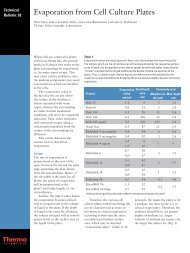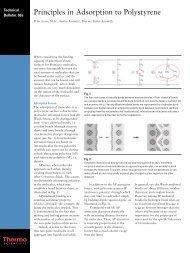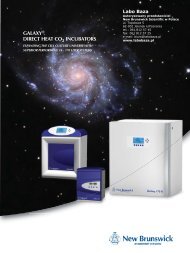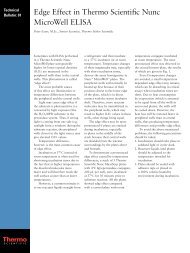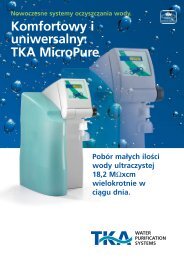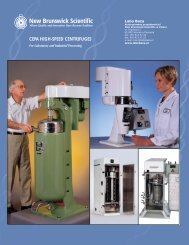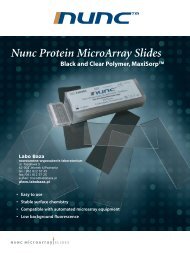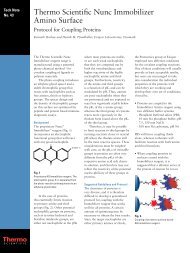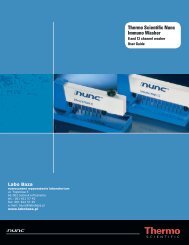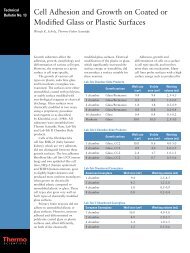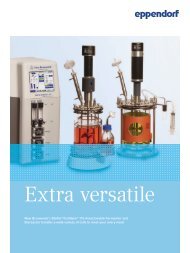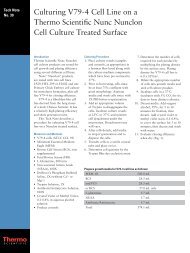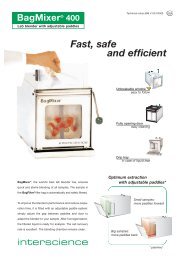Reproducible photometric determination of DNA ... - Labo Baza
Reproducible photometric determination of DNA ... - Labo Baza
Reproducible photometric determination of DNA ... - Labo Baza
You also want an ePaper? Increase the reach of your titles
YUMPU automatically turns print PDFs into web optimized ePapers that Google loves.
Applications<br />
Note 228 | September 2010<br />
<strong>Reproducible</strong> <strong>photometric</strong> <strong>determination</strong> <strong>of</strong> <strong>DNA</strong><br />
concentrations using the Eppendorf UVette® in<br />
the Eppendorf BioPhotometer plus<br />
Martin Armbrecht, Eppendorf AG, Hamburg, Germany<br />
Jennifer Oduro, Charité, Berlin, Germany<br />
Abstract<br />
<strong>DNA</strong> concentrations are typically determined <strong>photometric</strong>ally with the help <strong>of</strong> re-usable quartz cuvettes. This article<br />
will demonstrate that these measurements yield equally good results when performed using single-use plastic<br />
cuvettes like the Eppendorf UVette. To this end, measurements <strong>of</strong> different <strong>DNA</strong> concentrations were carried out<br />
in the UVette, using the Eppendorf BioPhotometer plus. The reproducibility <strong>of</strong> this system was demonstrated with<br />
the help <strong>of</strong> the calculated coefficient <strong>of</strong> variation. Series <strong>of</strong> measurements were generated using the 2 mm light<br />
path, as well as the 10 mm light path, <strong>of</strong> the Eppendorf UVette, and compared to a quartz cuvette.<br />
Introduction<br />
It is common practice to perform <strong>photometric</strong> nucleic<br />
acid <strong>determination</strong>s in cuvettes made from quartz, as it is<br />
commonly assumed that plastics are not UV-transparent<br />
and therefore, not suitable for nucleic acid measurements.<br />
As we will show in this article, <strong>photometric</strong> measurements<br />
in the UV range can be performed reproducibly in the<br />
Eppendorf UVette, as the special plastic is UV-transparent.<br />
Thus, the Eppendorf UVette is one <strong>of</strong> the few singleuse<br />
cuvettes made from plastic which may be used for<br />
measurements in the UV-range.<br />
Single use cuvettes such as the Eppendorf UVettes have<br />
an advantage over re-usable cuvettes made from quartz in<br />
that the sample to be measured cannot be contaminated<br />
by preceding samples. In addition, a sample volume <strong>of</strong><br />
50 µL is sufficient for reproducible measurements in the<br />
UVette. The standard light path for the UVette is 10 mm.<br />
However, highly concentrated solutions may be measured<br />
in the additional light path <strong>of</strong> 2 mm (see figure 1). For this<br />
application, the UVette is simply rotated by 90°. Thus, the<br />
UVette <strong>of</strong>fers the flexibility to measure with two different<br />
light paths, where normally two different cuvettes would be<br />
used. This feature allows for a considerable expansion <strong>of</strong><br />
the measurable range <strong>of</strong> sample concentrations.<br />
This article shows that reproducible measurements in the<br />
UV range may be carried out using both light paths.<br />
Figure 1: Eppendorf UVette<br />
Two light paths are available for <strong>photometric</strong> measurements,<br />
combined in one cuvette: the standard 10 mm light path (purple)<br />
and a 2 mm light path (violet).
Application Note 228 | page 2<br />
Materials and Methods<br />
1) Verification <strong>of</strong> reproducibility via measurements in the UV<br />
range using the Eppendorf UVette, employing both possible<br />
light paths <strong>of</strong> 2 mm and 10 mm.<br />
Materials<br />
Eppendorf BioPhotometer plus<br />
UVettes<br />
BioPhotometer Data Transfer S<strong>of</strong>tware<br />
Human genomic <strong>DNA</strong> (Promega, approx. 200 ng/µL<br />
(manufacturer’s specifications), measured approx. 238 ng/µL)<br />
Water (molecular biology grade), pH 7.0<br />
Eppendorf Research Pipettes<br />
epT.I.P.S.<br />
Thermo printer DPU 414<br />
Hellma Ultra micro cuvette made from quartz glass (path<br />
length 10 mm, QS105.202)<br />
Method<br />
2 serial dilutions each were generated using the human<br />
genomic <strong>DNA</strong>, where the stock solution in each serial<br />
dilution was diluted 1:2, 1:4 and 1:8. Each dilution step <strong>of</strong><br />
each serial dilution was measured 10 times. The undiluted<br />
solution and the 1:2 dilution were measured using the 2 mm<br />
light path, whereas the 1:4 and 1:8 diluted <strong>DNA</strong> solutions<br />
were measured in the 10 mm light path.<br />
For the purpose <strong>of</strong> comparing reproducibility, the latter<br />
dilutions were also measured in cuvettes made from quartz<br />
glass.<br />
The use <strong>of</strong> the respective path length was taken into<br />
consideration during programming <strong>of</strong> the parameters in<br />
the BioPhotometer plus (fig. 2). The 10 measurements<br />
per dilution series were performed sequentially. A mean<br />
value was determined for each series <strong>of</strong> measurements,<br />
as well as the maximum deviation from the mean and the<br />
coefficient <strong>of</strong> variation.<br />
Fig. 2: Programming <strong>of</strong> the 2 mm light path in parameters for<br />
the method ds<strong>DNA</strong><br />
Results and Discussion<br />
1) Reproducibility <strong>of</strong> <strong>photometric</strong> <strong>DNA</strong> <strong>determination</strong>s using<br />
Eppendorf UVettes and the BioPhotometer plus<br />
In order to verify the reproducibility <strong>of</strong> <strong>photometric</strong> <strong>DNA</strong><br />
measurements in Eppendorf UVettes, measurements were<br />
carried out in two concentration ranges. To this end, <strong>DNA</strong><br />
samples were measured ten times in different cuvettes. For<br />
samples with concentrations above 100 ng/µL the 2 mm<br />
light path was used. Samples <strong>of</strong> lower concentration were<br />
measured using the 10 mm light path <strong>of</strong> the UVette, as well<br />
as a quartz glass cuvette for comparison.<br />
The absorption results at 230, 260 and 280 nm are<br />
displayed for each series <strong>of</strong> measurements, along with the<br />
<strong>DNA</strong> concentration. The 340 nm results are not displayed,<br />
as this experiment was performed with ultra pure <strong>DNA</strong>, thus<br />
rendering impurities highly improbable.<br />
For the purpose <strong>of</strong> determining reproducibility, the mean<br />
value was calculated, as well as the standard deviation <strong>of</strong><br />
each measured series, and the coefficient <strong>of</strong> variation. The<br />
series <strong>of</strong> measurements were determined using the method<br />
ds<strong>DNA</strong> on the BioPhotometer plus, as this instruments<br />
allows for clear simultaneous display <strong>of</strong> all parameters<br />
relevant for <strong>DNA</strong> measurements. The results are shown in<br />
tables 1A through 1D.
Application Note 228 | page 3<br />
Table 1A: Result <strong>of</strong> measurements using undiluted <strong>DNA</strong> solutions (2 mm light path) - UVette<br />
1. UVette<br />
2 mm path length<br />
Concentration<br />
[ng/µL]<br />
2. UVette<br />
2 mm path length<br />
Concentration<br />
[ng/µL]<br />
Wavelength [nm] 230 260 280 230 260 280<br />
Sample 1 0.561 0.951 0.516 237.8 0.56 0.953 0.516 238.2<br />
Sample 2 0.56 0.951 0.515 237.7 0.561 0.952 0.516 237.9<br />
Sample 3 0.561 0.953 0.515 238.2 0.561 0.95 0.516 237.5<br />
Sample 4 0.56 0.95 0.516 237.8 0.561 0.951 0.515 237.9<br />
Sample 5 0.562 0.951 0.516 237.8 0.561 0.952 0.514 238<br />
Sample 6 0.561 0.951 0.515 237.8 0.561 0.952 0.516 238<br />
Sample 7 0.562 0.952 0.515 237.9 0.562 0.953 0.516 238.3<br />
Sample 8 0.562 0.952 0.515 238 0.562 0.953 0.516 238.1<br />
Sample 9 0.564 0.953 0.516 238.3 0.564 0.953 0.516 238.3<br />
Sample 10 0.565 0.954 0.516 238.5 0.565 0.953 0.516 238.2<br />
Mean 0.562 0.952 0.516 237.980 0.562 0.952 0.516 238.040<br />
Standard deviation 0.0012 0.0010 0.0005 0.2160 0.0012 0.0008 0.0005 0.1800<br />
Coefficient <strong>of</strong> variation (CV) 0.3 % 0.1 % 0.1 % 0.1 % 0.3 % 0.1 % 0.1 % 0.1 %<br />
Table 1B: Result <strong>of</strong> measurements using 1:2 diluted <strong>DNA</strong> solutions (2 mm light path) - UVette<br />
1. UVette<br />
2 mm path length<br />
1. UVette<br />
10 mm path length<br />
Concentration<br />
[ng/µL]<br />
Concentration<br />
[ng/µL]<br />
2. UVette<br />
2 mm path length<br />
2. UVette<br />
10 mm path length<br />
Concentration<br />
[ng/µL]<br />
Wavelength [nm] 230 260 280 230 260 280<br />
Sample 1 0.272 0.463 0.252 115.7 0.272 0.462 0.251 115.6<br />
Sample 2 0.272 0.463 0.252 115.8 0.273 0.464 0.253 116<br />
Sample 3 0.272 0.464 0.252 116.1 0.273 0.465 0.253 116.2<br />
Sample 4 0.272 0.465 0.252 116.3 0.272 0.464 0.254 116.1<br />
Sample 5 0.273 0.465 0.252 116.3 0.274 0.467 0.254 116.6<br />
Sample 6 0.274 0.466 0.253 116.5 0.274 0.466 0.253 116.6<br />
Sample 7 0.274 0.466 0.253 116.5 0.275 0.468 0.254 116.9<br />
Sample 8 0.274 0.467 0.253 116.8 0.276 0.469 0.255 117.4<br />
Sample 9 0.276 0.468 0.254 117 0.275 0.467 0.254 116.8<br />
Sample 10 0.275 0.468 0.254 117 0.274 0.469 0.255 117.2<br />
Mean 0.273 0.466 0.253 116.400 0.274 0.466 0.254 116.540<br />
Standard deviation 0.0012 0.0015 0.0007 0.3600 0.0010 0.0019 0.0009 0.4520<br />
Coefficient <strong>of</strong> variation (CV) 0.5 % 0.4 % 0.3 % 0.4 % 0.5 % 0.5 % 0.5 % 0.5 %<br />
Table 1C: Result <strong>of</strong> measurements using 1:4 diluted <strong>DNA</strong> solutions (10 mm light path) - UVette<br />
Concentration<br />
[ng/µL]<br />
Wavelength [nm] 230 260 280 230 260 280<br />
Sample 1 0.688 1.174 0.633 57.8 0.686 1.17 0.632 58.5<br />
Sample 2 0.689 1.176 0.633 58.8 0.687 1.17 0.632 58.5<br />
Sample 3 0.688 1.176 0.632 58.8 0.686 1.17 0.632 58.5<br />
Sample 4 0.688 1.176 0.633 58.8 0.686 1.173 0.633 58.6<br />
Sample 5 0.689 1.176 0.633 58.8 0.687 1.173 0.632 58.7<br />
Sample 6 0.69 1.177 0.634 58.9 0.687 1.171 0.632 58.6<br />
Sample 7 0.69 1.177 0.635 58.9 0.688 1.173 0.633 58.7<br />
Sample 8 0.691 1.178 0.634 58.9 0.687 1.172 0.633 58.6<br />
Sample 9 0.691 1.18 0.634 59 0.688 1.174 0.633 58.7<br />
Sample 10 0.691 1.178 0.634 58.9 0.688 1.172 0.632 58.6<br />
Mean 0.690 1.177 0.634 58.850 0.687 1.172 0.632 58.600<br />
Standard deviation 0.0011 0.0012 0.0007 0.0700 0.0006 0.0012 0.0005 0.0600<br />
Coefficient <strong>of</strong> variation (CV) 0.2 % 0.1 % 0.1 % 0.1 % 0.1 % 0.1 % 0.1 % 0.1 %
Application Note 228 | page 4<br />
Table 1D: Result <strong>of</strong> measurements using 1:8 diluted <strong>DNA</strong> solutions (10 mm light path) - UVette<br />
1. UVette<br />
10 mm path length<br />
Concentration<br />
[ng/µL]<br />
2. UVette<br />
10 mm path length<br />
Concentration<br />
[ng/µL]<br />
Wavelength [nm] 230 260 280 230 260 280<br />
Sample 1 0.344 0.594 0.322 29.7 0.345 0.593 0.321 29.7<br />
Sample 2 0.345 0.595 0.322 29.7 0.344 0.594 0.32 29.7<br />
Sample 3 0.345 0.596 0.322 29.8 0.344 0.594 0.321 29.8<br />
Sample 4 0.345 0.596 0.322 29.8 0.344 0.595 0.321 29.8<br />
Sample 5 0.345 0.594 0.322 29.7 0.344 0.595 0.322 29.8<br />
Sample 6 0.344 0.595 0.322 29.8 0.343 0.595 0.322 29.8<br />
Sample 7 0.346 0.597 0.324 29.8 0.344 0.595 0.322 29.8<br />
Sample 8 0.346 0.597 0.323 29.8 0.345 0.597 0.322 29.8<br />
Sample 9 0.346 0.598 0.325 29.9 0.344 0.597 0.322 29.8<br />
Sample 10 0.346 0.597 0.323 29.9 0.344 0.596 0.322 29.8<br />
Mean 0.345 0.596 0.323 29.790 0.344 0.595 0.322 29.780<br />
Standard deviation 0.0006 0.0011 0.0008 0.0540 0.0004 0.0009 0.0006 0.0320<br />
Coefficient <strong>of</strong> variation (CV) 0.2 % 0.2 % 0.3 % 0.2 % 0.2 % 0.2 % 0.2 % 0.1 %<br />
Table 1E: Result <strong>of</strong> measurements using 1:4 and 1:8 diluted <strong>DNA</strong> solutions (10 mm light path) – quartz cuvette<br />
1.<br />
Quartz cuvette 10<br />
mm path length<br />
(1:4 dilutied <strong>DNA</strong>)<br />
Concentration<br />
[ng/µL]<br />
2.<br />
Quartz cuvette 10<br />
mm path length<br />
(1:8 dilutied <strong>DNA</strong>)<br />
Concentration<br />
[ng/µL]<br />
Wavelength [nm] 230 260 280 230 260 280<br />
Sample 1 0.677 1.156 0.642 57.8 0.341 0.584 0.327 29.2<br />
Sample 2 0.678 1.156 0.642 57.8 0.341 0.583 0.326 29.15<br />
Sample 3 0.677 1.156 0.643 57.8 0.341 0.584 0.327 29.2<br />
Sample 4 0.675 1.155 0.641 57.75 0.341 0.585 0.328 29.25<br />
Sample 5 0.677 1.155 0.641 57.75 0.341 0.584 0.327 29.2<br />
Sample 6 0.677 1.157 0.642 57.85 0.342 0.585 0.327 29.25<br />
Sample 7 0.678 1.156 0.642 57.8 0.343 0.585 0.328 29.25<br />
Sample 8 0.677 1.157 0.643 57.85 0.341 0.584 0.328 29.2<br />
Sample 9 0.678 1.156 0.643 57.8 0.343 0.586 0.33 29.3<br />
Sample 10 0.678 1.156 0.643 57.8 0.344 0.586 0.329 29.3<br />
Mean 0.677 1.156 0.632 57.800 0.342 0.585 0.328 29.23<br />
Standard deviation 0.0006 0.0004 0.0006 0.0200 0.0010 0.0008 0.0009 0.0400<br />
Coefficient <strong>of</strong> variation (CV) 0.1 % 0.1 % 0.1 % 0.1 % 0.3 % 0.2 % 0.4 % 0.2 %<br />
The series <strong>of</strong> measurements using high <strong>DNA</strong> concentrations<br />
(undiluted and diluted 1:2), performed in the 2 mm light path,<br />
show a coefficient <strong>of</strong> variation (CV) <strong>of</strong> 0.3 % to 0.5 % for all<br />
wavelengths. The standard deviation <strong>of</strong> the mean is between<br />
0.001 A and 0.002 A.<br />
For the 1:4 and 1:8 diluted <strong>DNA</strong> solutions, the CV <strong>of</strong> the<br />
respective series <strong>of</strong> measurements falls between 0.1 % and<br />
0.3 %, and the standard deviation is 0.001 A.<br />
Table 1E shows that the standard deviations obtained with<br />
quartz cuvettes are similarly low.<br />
The results clearly show that reproducible measurements<br />
in the UV range are equally possible in Eppendorf UVettes<br />
made from plastic as they are in quartz cuvettes. This is true<br />
for the 2 mm as well as the 10 mm light path.
Application Note 228 | page 5<br />
With regards to reproducibility, the <strong>photometric</strong> accuracy <strong>of</strong><br />
measured results obtained in the BioPhotometer plus may<br />
be verified using a set <strong>of</strong> calibration filters, the Secondary<br />
UV-VIS-Filter Set [1]. For this purpose, 3 broad range filters<br />
are used which yield an absorption <strong>of</strong> approximately 0.2 A at<br />
260 nm (filter A1), 0.8 A (filter A2) and 1.4 A (filter A3). During<br />
calibration, filter A1 may show a maximum CV <strong>of</strong> 3 %, filter<br />
A2 may show a maximum CV <strong>of</strong> 1 % and filter A3 may show<br />
a maximum CV <strong>of</strong> 1.5 %. Figure 3 summarizes the CV values<br />
obtained from the series <strong>of</strong> measurements using the UVette<br />
and the glass cuvettes. Figure 3 shows that the coefficients<br />
<strong>of</strong> variation measured in the UVette as well as in the quartz<br />
cuvettes are clearly below the maximum permitted CVs <strong>of</strong><br />
the UV-VIS filter set.<br />
These results underline the reproducibility <strong>of</strong> measurements<br />
obtained using the UVette.<br />
Conclusion<br />
This article was able to demonstrate that single-use UV<br />
cuvettes made from plastic, such as the Eppendorf UVette,<br />
are capable <strong>of</strong> producing reproducible measurements in the<br />
UV range. As verified by the series <strong>of</strong> measurements using<br />
ds<strong>DNA</strong>, the deviations for both the 2 mm light path, as well<br />
as the 10 mm light path, are well within the technical specifications<br />
<strong>of</strong> the BioPhotometer plus, which was used for these<br />
measurements. The fact that both path lengths showed high<br />
reproducibility during these measurements underlines the flexible<br />
application possibilities <strong>of</strong> the UVettes during measurements<br />
in the UV range. In addition, the possibility to measure<br />
higher concentrations using the same cuvette and a shorter<br />
light path is to date a unique feature among plastic cuvettes.<br />
Fig. 3: Measured CVs obtained from series <strong>of</strong> measurements UVette and quartz cuvettes in comparison to the maximum<br />
permitted CVs <strong>of</strong> the calibration filters (Secondary UV-VIS Filter Set).<br />
Blue lines: permitted coefficients <strong>of</strong> variation <strong>of</strong> the calibration filters A1, A2, A3 at 260 nm<br />
B1-E2: CVs <strong>of</strong> the series <strong>of</strong> measurements obtained from the measurements using the UVette at 260 nm<br />
F1-F2: CVs <strong>of</strong> the measurements obtained with quartz cuvettes at 260 nm.
Application Note 228<br />
Literature<br />
[1] Eppendorf UserGuide No. 10, Evaluating the functionality <strong>of</strong> the Eppendorf BioPhotometer plus using the Secondary<br />
UV-VIS Filter Set. www.eppendorf.com<br />
Ordering Information<br />
Description<br />
Order No.<br />
International<br />
Order No.<br />
North America<br />
Eppendorf BioPhotometer plus, 230 V / 50 - 60 Hz 6132 000.008 -<br />
Eppendorf BioPhotometer plus, 120 V / 50 - 60 Hz - 952000006<br />
Thermo printer DPU 414 Incl. adapter and printer cable 230 V 6131 011.006 -<br />
Thermal Printer DPU 414, serial printer incl. power supply 120 V/60 Hz unit and printer cable - 952010140<br />
Printer Paper, 5 rolls 0013 021.566 952010409<br />
UVette ® Original Eppendorf plastic cuvettes, individually wrapped, Usable directly in the<br />
0030 106.300 952010051<br />
BioPhotometer, certified RNase-, <strong>DNA</strong> and protein free, pack <strong>of</strong> 80<br />
UVette ® routine pack Eppendorf Quality purity, re-sealable box<br />
0030 106.318 952010069<br />
Pack <strong>of</strong> 200<br />
Cuvette rack For 16 cuvettes 4308 078.006 940001102<br />
BioPhotometer Data Transfer S<strong>of</strong>tware 6132 854.007 952000500<br />
Secondary UV-VIS-Filter<br />
Test filter set for verification <strong>of</strong> <strong>photometric</strong> and wavelength accuracy (in accordance with NIST)<br />
6131 928.007 952010221<br />
Hellma ® is a registered trademark <strong>of</strong> the Hellma GmbH & Co.KG<br />
eppendorf ® , UVette ® , epT.I.P.S. ® and Eppendorf Research ® are registered trademarks <strong>of</strong> Eppendorf AG • Eppendorf BioPhotometer plus is a used trademark <strong>of</strong> Eppendorf AG<br />
All rights reserved, including graphics and images • Copyright © 2010 by Eppendorf AG<br />
Order-No. AA22 8WW 020/GB1/0910/0T/CR<br />
Your local distributor: www.eppendorf.com/worldwide<br />
Eppendorf AG · 22331 Hamburg · Germany · Tel: +49 40 53801-0 · Fax: +49 40 538 01-556 · E-mail: eppendorf@eppendorf.com<br />
Eppendorf North America, Inc. · 102 Motor Parkway · Hauppauge, N.Y. 11788-5178 · USA<br />
Tel: +1 516 334 7500 · Toll free phone: +1 800-645-3050 · Fax: +1 516 334 7506 · E-mail: info@eppendorf.com<br />
Application Support Europe, International: Tel: +49 1803 666 789 · E-mail: support@eppendorf.com<br />
North America: Tel: +1 800 645 3050 · E-mail: techserv@eppendorf.com<br />
Asia Pacific: Tel: +60 3 8023 6869 · E-mail: support_asiapacific@eppendorf.com



